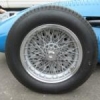I'm pretty sure on old F1 engine could manage 1000 miles running at light load and low rpm. Not sure I would call those top cars small budget as I would think you could buy a nice house for the cost of those cars. A lot of these turbo cars are running manifold pressures in the 400kpa+ region which isn't that far from what the turbo cars were running so I don't think E85 or Methanol can be considered much lower than jungle juice.
E85 is pump fuel. Many production cars use it, though not too many sites carry it. But $1.40 a litre in comparison today with some site asking $1.69 for 91 and 20-25c extra for 98. I am converting my Falcon race car too use it. Doing it properly has cost about $1100, for carb, pump, hoses and fuel regulator. Though you can buy the metering blocks from Holley and change jets and power valves etc. And flush the system when leaving the car sitting.
As I will do with the Classic Supermodified, hoses, filter and retune the SUs for the fuel.
E85 is like all ethanol fuels, it is hydroscopic and absorbs too much water. Which is what causes the corrosion, not the fuel.
Methanol is a bit harder to convert too but really not much different. And is a LOT more stable now than in the past. And it too causes corrosion with the water it absorbs.
Methanol is far from jungle juice as well. The very high chemical stuff run in high dollar 50s engines and the BMW F1 engines was downright dangerous.
Both fuels have the capacity to make more power but the engine needs compression and airflow to do so.
Most E85 production engines have a bit less power.
And ofcourse a fuel stabiliser than lubricates valves and top ring area is also required as both fuels are a lot 'drier' But so is unleaded!






















